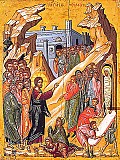GREAT LENT QUICK LINKS:
Great Lent - Main I Pre-Lenten Period I Lenten Worship I On Fasting I On Confession
The Sundays of Great Lent are like bright signposts for our journey to Holy Week and Pascha. Each one has a specific commemoration, the lessons of which refresh and bolster us for the rigorous efforts of the Fast. Everything about Great Lent, including its unique worship, instructs and informs us. Thus Lent is often called the "School of Repentance." After reading this brief introduction to the Sundays of Lent, we invite you to spend a little time as the weeks go by exploring each Sunday more fully, on the following special pages.
|
The First Sunday is called the Feast of the Triumph of Orthodoxy. It is a historical feast commemorating the return of the icons to the churches in the year 843 after the heresy of iconoclasm was overcome. The spiritual theme of the day is first of all the victory of the True Faith. “This is the victory that overcomes the world, our faith” (1 Jn 5:4). Secondly, the icons of the saints bear witness that man, “created in the image and likeness of God” (Gen 1:26), becomes holy and godlike through the purification of himself as God’s living image. Continue reading...
The Third Sunday of Lent is that of the Veneration of the Cross. The cross stands in the midst of the church in the middle of the lenten season not merely to remind men of Christ’s redemption and to keep before them the goal of their efforts, but also to be venerated as that reality by which man must live to be saved. “He who does not take up his cross and follow me is not worthy of me” (Mt 10:38). For in the Cross of Christ Crucified lies both “the power of God and the wisdom of God” for those being saved (1 Cor 1:24). Continue reading...
The Fifth Sunday recalls the memory of Saint Mary of Egypt, the repentant harlot. Mary tells us, first of all, that no amount of sin and wickedness can keep a person from God if he truly repents. Christ himself has come “to call sinners to repentance” and to save them from their sins (Lk 5:32). In addition, Saint Mary tells us that it is never too late in life—or in Lent—to repent. Christ will gladly receive all who come to him even at the eleventh hour of their lives. But their coming must be in serious and sincere repentance.Continue reading... |
The Second Sunday of Lent is the commemoration of St Gregory Palamas. It was St. Gregory (d.1359) who bore living witness that men can become divine through the grace of God in the Holy Spirit; and that even in this life, by prayer and fasting, with the grace of God, human beings can become participants of the uncreated light of God’s divine glory. Continue reading...
The Fourth Sunday of Lent is dedicated to St John of the Ladder (Climacus). The author of the work, The Ladder of Divine Ascent, abbot of St Catherine’s Monastery on Mount Sinai (6th century), stands as a witness to the violent effort needed for entrance into God’s Kingdom (Mt 10: 12). The spiritual struggle of the Christian life is a real one, “not against flesh and blood, but against… the rulers of the present darkness… the hosts of wickedness in heavenly places ...” (Eph 6:12). Saint John encourages the faithful in their efforts for, according to the Lord, only “he who endures to the end will be saved” (Mt 24:13). Continue reading...
At the end of Great Lent, following the Sixth Week, we celebrate the Festal Interlude of Lazarus Saturday and Palm Sunday, before solemnly entering into Holy Week the evening of Palm Sunday. The Lord raises his friend Lazarus, dead four days, and makes His triumphal entry into Jerusalem, knowing His sufferings for the sake of mankind are about to begin. Continue reading... |

